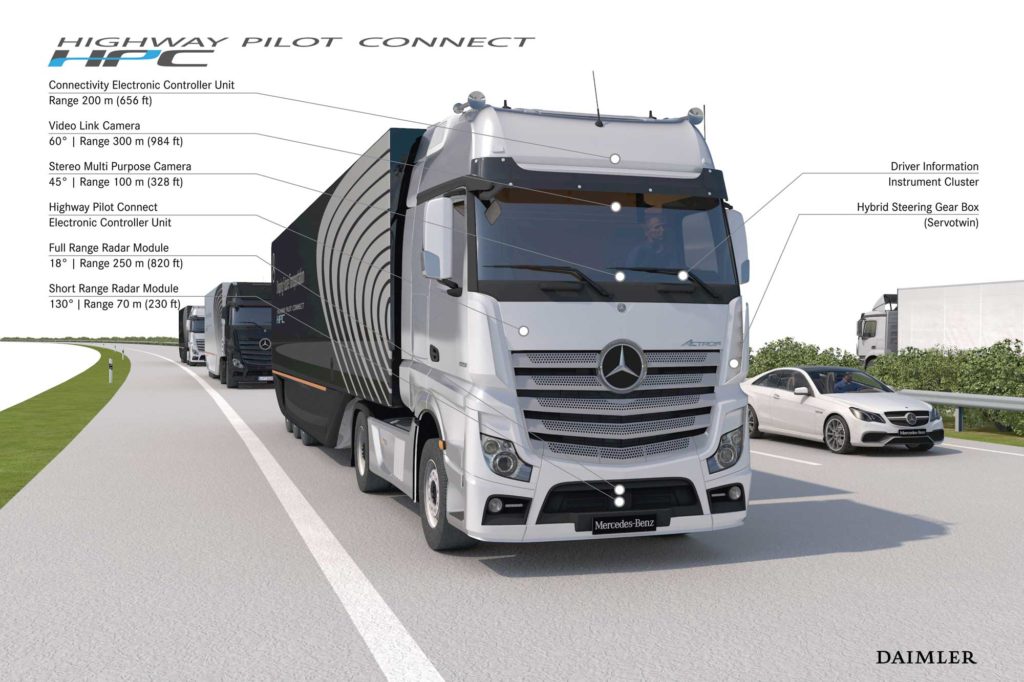Daimler Trucks has launched its Highway Pilot Connect system with a self-driving, WiFi-connected, three-truck platoon
120 years after the invention of the truck, Daimler Trucks is bringing the truck into the internet. Recently, Daimler Trucks presented an impressive example of the possibilities opened up by the digital connection of trucks: Three WiFi-connected, autonomously driving trucks operated on the autobahn with authorisation for public traffic as a platoon. “Such a combination can reduce fuel consumption by up to seven per cent and the road space requirement on motorways by almost half – while improving traffic safety at the same time,” the German truck maker claims.
Around 365,000 Daimler trucks around the world are already connected via the FleetBoard and Detroit Connect systems. Daimler Trucks is driving the systematic connectivity of its vehicles ahead with all parties involved in the logistical and transport process. The company says the completely connected truck initiates a radical
change in transport which will make road goods traffic even more effective and efficient – not only for drivers, haulers and vehicle manufacturers, but also for society as a whole.
Based on the Daimler Trucks Highway Pilot system for autonomously driving heavy trucks, the three trucks link up to form an aerodynamically optimised, fully automated platoon. Daimler Trucks calls this advanced system development Highway Pilot Connect.
Dr Wolfgang Bernhard, member of the Board of Management of Daimler AG with responsibility for Daimler Trucks and Buses, explains, “We are connecting the truck with the internet – making him the mobile data centre of the logistics network. It connects all those involved in goods: drivers, schedulers, fleet operators, workshops, manufacturers and insurance companies or authorities. They receive information in real time which was previously unavailable: about the condition of the tractor unit and semitrailer, traffic and weather conditions, the parking availability at motorway service stations, rest areas and much more.”
He adds, “Our trucks fully connect with their environment, becoming part of the internet and continuously sending and receiving information. All those involved in the logistical process can use these real-time data for their needs. In the future it will e.g. be possible to reduce waiting times while loading and unloading, reduce paperwork and avoid traffic jams. With flash updates over the air or automated transfer of inbound time for trucks heading to the service point maintenance time can be reduced significantly. In this way we are considerably improving the performance of goods transport as a whole.”
The worldwide transport of goods is a prerequisite for economic growth. However, transporting more goods in the future requires innovative solutions if we are to avoid traffic gridlock. One central approach is to fully network the truck with the internet of things. Daimler’s smart trucks have the potential to radically change road goods transport in the coming years. Already today, Daimler Trucks generates valuable information to a previously unimaginable extent with its approximately 400 sensors per vehicle and is fully connected with software including 100 millions of lines of code – more than a passenger jet.
Dr Bernhard says, “For efficient logistics real time data are essential – and our trucks supply these data. Therefore we are investing around half a billion Euros by 2020 to connect our trucks with their environment and develop specific new applications. This will enhance our customers’ performance to operate their businesses safer and more environmentally friendly. FleetBoard and Detroit Connect will considerably help to leverage previously unharvested potential in road transport – both in the highly developed triad markets and in the emerging economies of Africa, Asia and Latin America.”
The trucks use the vehicle-to-vehicle (V2V) networking known as Highway Pilot Connect that allows electronic docking by vehicles on motorways and long-distance highways, also known as platooning. Communication between vehicles is made possible by an onboard telematics platform. A specific V2V communication module using a special WiFi standard reserved exclusively for automotive enables direct data transfer between the trucks. Highway Pilot Connect uses this for a constant exchange of information with other trucks and the environment.
They are able to maintain their direction independently of the vehicle ahead, and thanks to their combination of linear and lateral guidance, they can react to unexpected situations at any time. This also applies if other vehicles cut into or leave the platoon’s space. In this case the vehicle can smoothly disengage from the platoon and continue alone in autonomous mode. The driver does not need to intervene.
Cookie Consent
We use cookies to personalize your experience. By continuing to visit this website you agree to our Terms & Conditions, Privacy Policy and Cookie Policy.


















